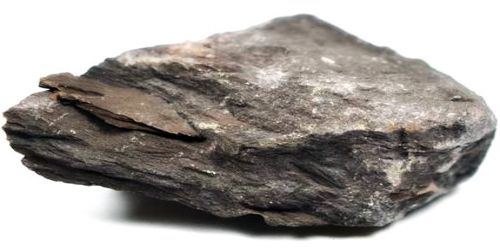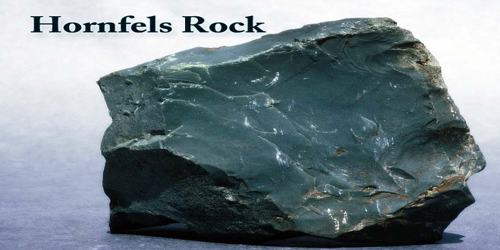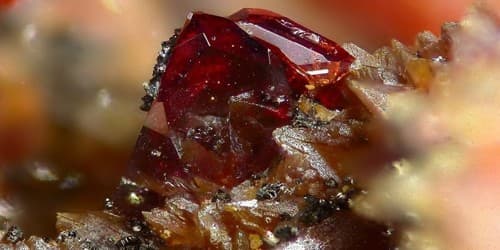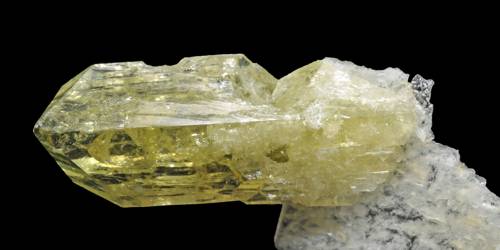Definition –
Hornfels is a fine-grained metamorphic rock that was formed by the contact between mudstone/shale, or other clay-rich rock, and a hot igneous body, and represents a heat-altered equivalent of the original rock. It is the group name for a set of contact metamorphic rocks that have been baked and hardened by the heat of intrusive igneous masses and have been rendered massive, hard, splintery, and in some cases exceedingly tough and durable. These properties are due to fine-grained non-aligned crystals with platy or prismatic habits. The term is derived from the German word Hornfels, meaning “hornstone”, because of its exceptional toughness and texture both reminiscent of animal horns. These rocks were referred to by miners in northern England as whetstones.
Hornfels was “baked” by heat conducted from a nearby magma chamber, sill, dike, or lava flow. Common temperatures for the formation of hornfels range from about 1300 to 1450 degrees Fahrenheit (700 to 800 degrees Celsius). Because directed pressure does not play a significant role in the formation of hornfels, it is often made up of mineral grains that are equidimensional in shape and without a preferred orientation. The grain shape and orientation might also be inherited from its parent rock.
Most hornfels are fine-grained, and while the original rocks (such as sandstone, shale, slate, and limestone) may have been more or less fissile owing to the presence of bedding or cleavage planes, this structure is effaced or rendered inoperative in the hornfels. Though they may show banding, due to bedding, etc., they break across this as readily as along it; in fact, they tend to separate into cubical fragments rather than into thin plates.
The name “hornfels” is assigned to rock after considering its grain size, texture, and geologic history. As a result, hornfels does not have a specific chemical or mineralogical composition. It inherits its composition from the rocks that are metamorphosed plus the fluids involved in the metamorphic process. Interpreting composition, grain size, texture, and geologic history can make hornfels a very difficult rock to identify.
The most common hornfels (the biotite hornfels) are dark-brown to black with a somewhat velvety luster owing to the abundance of small crystals of shining black mica. The lime hornfels are often white, yellow, pale green, brown and other colors. Green and dark-green are the prevalent tints of the hornfels produced by the alteration of igneous rocks. Although for the most part the constituent grains are too small to be determined by the unaided eye, there are often larger crystals of cordierite, garnet or andalusite scattered through the fine matrix, and these may become very prominent on the weathered faces of the rock.

Some Interesting Facts of Hornfels Rock –
- The structure of the hornfels is characterized by the small-grained mosaic make-up.
- Hornfels are used in a number of applications like in the field of construction and landscaping. It is used as a decorative rock in gardens. In the olden times, it is used as a tool like scrapers and knives.
- Hornfels is used as a road base and in concrete and is most often dark blue or almost a black color.
- The interior use of hornfels is found in homes and businesses in the decorative aggregates, flooring, countertops, and bathrooms.
- The exterior use of hornfels is viewed in building construction, paving stones, and a variety of gardening decorations.
- In prehistoric times, hornfels was used to make simple tools such as knives, scrapers, and arrowheads.
- Hornfels are defined by the physical properties such as hardness, strength, grain size, fracture, porosity, and streak. It is these physical properties that determine usage.
- Because pressure is not a main factor in the formation of hornfels, and the texture is granular, platy or elongated crystals, there is a lack of foliation as often seen in many metamorphic rocks formed under high pressure.
- During the formation of hornfels, the pre-existing rock is destroyed.
- Hornfels are typically found only by microscopic observation and not witnessed by eye alone. However, under a microscope the structure becomes very distinctive revealing the small-grained mosaic design.
- There is a second group of hornfels are called the calc-silicate hornfels which originate from the thermal alteration of impure limestone. These rocks are fine-grained, and even though they are often banded, they are tough and much harder than the original limestone.
- Hornfels have the ability to resonate when struck. The stones in South Africa are called “ring-stones” due to their ability to ring like a bell after being struck with an object.
Classification of Hornfels –
The Hornfels classification of mineral composition that can be seperate into one of three general group
- Pelitic Hornfels is derived from shale, slate, and schist
- Carbonate Hornfels is derived from limestone, dolomite or marble
- Mafic Hornfels is derived from mafic igneous rocks
Occurrences and Structures of Hornfels –
Hornfels occurs worldwide. In Europe, the largest reserves are in the United Kingdom. In North America, hornfels occurs in primarily in Canada. South American countries with large reserves include Bolivia, Brazil, Ecuador, and Colombia. Asian reserves are found in China, Russia, India, North Korea, South Korea, and Thailand. In Africa, hornfels is found in Tanzania, Cameroon, East Africa, and Western Africa. The rock is found in Australia and New Zealand, as well.
The structure of the hornfels is very characteristic. Very rarely do any of the minerals show crystalline form, but the small grains fit closely together like the fragments of a mosaic; they are usually of nearly equal dimensions. This has been called pflaster or pavement structure from the resemblance to rough pavement work. Each mineral may also enclose particles of the others; in the quartz, for example, small crystals of graphite, biotite, iron oxides, sillimanite or feldspar may appear in great numbers. Often the whole of the grains are rendered semi-opaque in this way. The minutest crystals may show traces of crystalline outlines; undoubtedly they are of new formation and have originated in situ. This leads us to believe that the whole rock has been recrystallized at a high temperature and in the solid state so that there was little freedom for the mineral molecules to build up well-individualized crystals. The regeneration of the rock has been sufficient to efface most of the original structures and to replace the former minerals more-or-less completely by new ones. But crystallization has been hampered by the solid condition of the mass and the new minerals are formless and have been unable to reject impurities, but have grown around them.
Parent Rocks and Protoliths –
Hornfels is not a rock that is “deposited”. Instead it is a rock type that forms when an existing rock is metamorphosed. The original rock that was metamorphosed is usually referred to as the “parent rock” or “protolith”.
A variety of sedimentary, igneous, and metamorphic rocks can be the protolith of hornfels. Common protoliths of hornfels include sedimentary rocks such as shale, siltstone, sandstone, limestone and dolomite; igneous rocks such as basalt, gabbro, rhyolite, granite, andesite and diabase; or, metamorphic rocks such as schist and gneiss.

Properties of Hornfels Rock –
Key properties of the Hornfels Rock include velvety texture and appearance, conchoidal fracture, and fine grain. It may be very hard and tough. It is a contact metamorphic rock, formed when magma bakes its source material.
It is a type of metamorphic rock that gets its name from its resemblance to animal horn. It forms when magma heats other rock, which may be igneous, metamorphic, or sedimentary.
The most common colors of hornfels are black and dark brown. It may be banded or occur in other colors. The colors depend on the composition of the original rock.
Formation of the Hornfels –
The Hornfels formed is a is a group designated for a series of contact metamorphism that have been baked and by the heat of magma chamber or from the intrusive igneous masses and are made into massive, hard, splintery, and in some cases exceedingly tough and durable. As of the contact metamorphism, pressure is not a factor in the formation of hornfels, it lacks the foliation as seen in many metamorphic rocks formed under high pressure and temperature. Pre-existing bedding and structure of the parent rock is generally destroyed in hornfels.
Compositions of Hornfels –
On the basis of mineral composition, most occurrences of hornfels can be separated into one of three general groups:
- Pelitic Hornfels: usually derived from shale, slate, and schist
- Carbonate Hornfels: usually derived from limestone, dolomite or marble
- Mafic Hornfels: usually derived from mafic igneous rocks
A wide range of minerals and mineral groups are encountered in hornfels. The minerals frequently seen include: actinolite, andalusite, augite, biotite, calcite, chlorite, cordierite, diopside, epidote, feldspars, garnet, graphite, hornblende, kyanite, pyrite, scapolite, sillimanite, sphene, tourmaline, and vesuvianite.
Uses of Hornfels Rock –
Hornfels have the ability to resonate when struck. Michael Tellinger had described these stones in South Africa also known as “ring-stones” due to their ability to ring like a bell. The Musical Stones of Skiddaw are an example of a lithophone made from hornfels.
The primary use of hornfels is in architecture. The hard, interesting-looking stone may be used to make interior flooring and decorations as well as exterior facing, paving, curbing, and decorations.
The rock is also used in the construction industry to make road aggregate. Historically, hornels has been used to construct monuments, cemetery markers, whetstones, artworks, and artifacts.
Information Sources
















